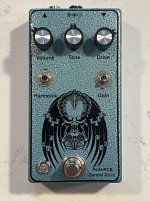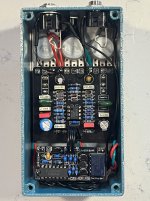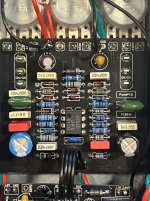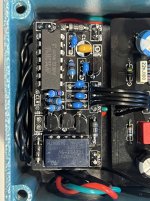- Build Rating
- 5.00 star(s)
Back when I first got into pedals, even before I started building them, I wanted a Barber Direct Drive. My interest in it ebbed and flowed over the years, but I never got around to acquiring one. I came really close to buying a used one on a couple occasions, but never actually went through with it. I did, however, purchase a used Gain Changer, which ultimately led me to designing my own Gain Changer clone PCB, the "Dynamic Haircut". I actually used the Dynamic Haircut on my board for a little while, but I'm pretty compulsively swapping drive pedals.
Still the Direct Drive lingered in the back of my mind, and when @Robert released the Candid Drive I jumped on it! I finished it up last night, but my family was all in bed, so could only do very low volume testing. I'm happy to say, it worked perfectly on first power-up!
Tonight I spent some more time with it, right next to my Aion Heliodor (aka Boss OD-3). I was surprised to find the two pedals are fairly close in tone. Not exact matches of course, but I think if you liked one, you'd probably like the other. In fact, I'd switch to one, play for a while, and have to look and see which one was on because I'd forget, and the tones weren't distinct enough to make it obvious. I really don't think it would be possible to tell the difference in a band mix. And the Candid Drive offers some more versatility I think, with the gain and harmonic switches. The circuits, at least at a high level, are really quite dissimilar: the Heliodor/OD-3 uses all discrete transistors (though arranges them like an opamp), with lots of tone shaping (see the great OD-3 analysis by @Chuck D. Bones); the Candid/Drive Drive has a dual opamp at it's core, with both hard and soft diode clipping, and a fair amount of tone shaping. Some day when I have the time and am sufficiently motivated, I'll have to study the various tone shaping filters between the two circuits to see if there are similarities.
The build process itself was unremarkable. Bypass is my CMOS-based relay bypass. I have a bunch of these PCBs, as well as some pre-populated SMD ones that are fairly small that I'm happy to give away if anyone wants one. It's a super-simple design that works great for simple on-off. The CMOS chip has a micro amp current draw, so other than when the relay is changing state, it uses virtually no power.
The enclosure is "Aqua Vein" from @StompBoxParts, and I did the graphics with a no-film waterslide decal. Hopefully everyone recognizes the character... if not, come out from under your rock, do yourself a favor and watch one the greatest movies of all time, Predator!
Still the Direct Drive lingered in the back of my mind, and when @Robert released the Candid Drive I jumped on it! I finished it up last night, but my family was all in bed, so could only do very low volume testing. I'm happy to say, it worked perfectly on first power-up!
Tonight I spent some more time with it, right next to my Aion Heliodor (aka Boss OD-3). I was surprised to find the two pedals are fairly close in tone. Not exact matches of course, but I think if you liked one, you'd probably like the other. In fact, I'd switch to one, play for a while, and have to look and see which one was on because I'd forget, and the tones weren't distinct enough to make it obvious. I really don't think it would be possible to tell the difference in a band mix. And the Candid Drive offers some more versatility I think, with the gain and harmonic switches. The circuits, at least at a high level, are really quite dissimilar: the Heliodor/OD-3 uses all discrete transistors (though arranges them like an opamp), with lots of tone shaping (see the great OD-3 analysis by @Chuck D. Bones); the Candid/Drive Drive has a dual opamp at it's core, with both hard and soft diode clipping, and a fair amount of tone shaping. Some day when I have the time and am sufficiently motivated, I'll have to study the various tone shaping filters between the two circuits to see if there are similarities.
The build process itself was unremarkable. Bypass is my CMOS-based relay bypass. I have a bunch of these PCBs, as well as some pre-populated SMD ones that are fairly small that I'm happy to give away if anyone wants one. It's a super-simple design that works great for simple on-off. The CMOS chip has a micro amp current draw, so other than when the relay is changing state, it uses virtually no power.
The enclosure is "Aqua Vein" from @StompBoxParts, and I did the graphics with a no-film waterslide decal. Hopefully everyone recognizes the character... if not, come out from under your rock, do yourself a favor and watch one the greatest movies of all time, Predator!
Attachments
Last edited:






